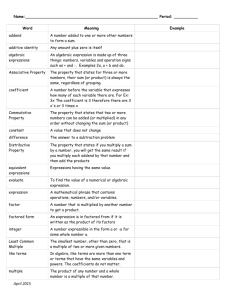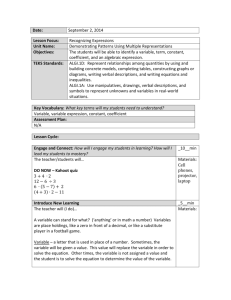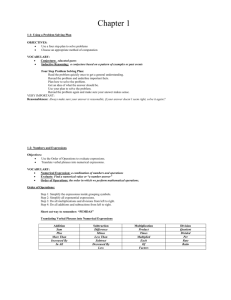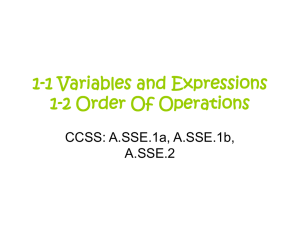Notes Chapter 1
advertisement
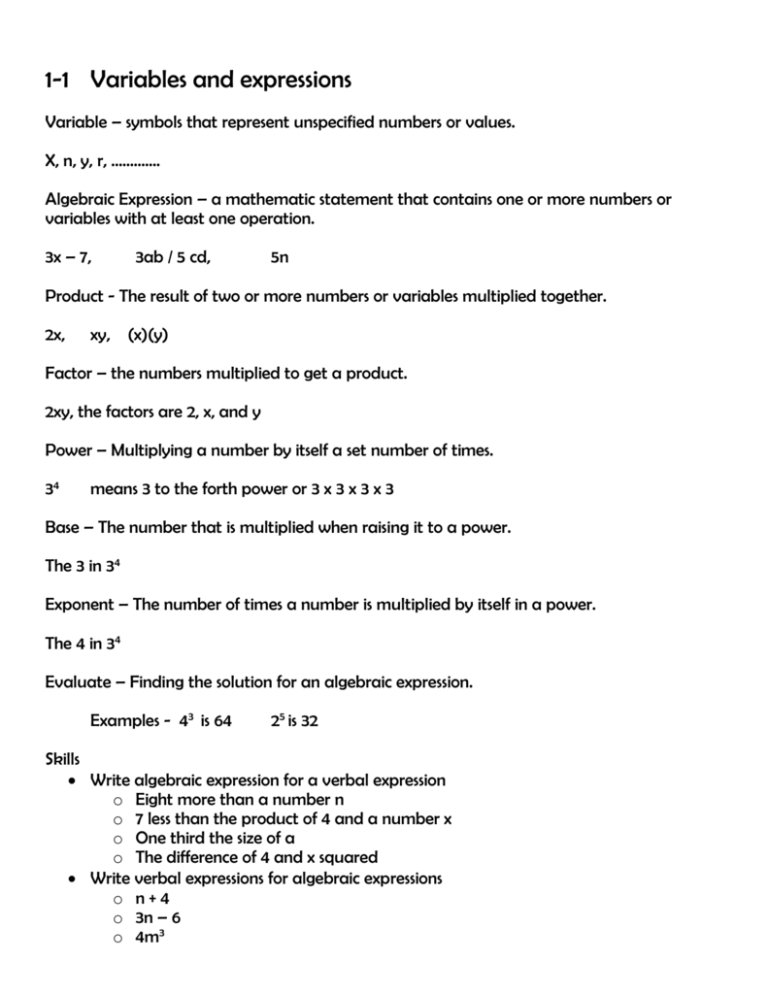
1-1 Variables and expressions Variable – symbols that represent unspecified numbers or values. X, n, y, r, …………. Algebraic Expression – a mathematic statement that contains one or more numbers or variables with at least one operation. 3x – 7, 3ab / 5 cd, 5n Product - The result of two or more numbers or variables multiplied together. 2x, xy, (x)(y) Factor – the numbers multiplied to get a product. 2xy, the factors are 2, x, and y Power – Multiplying a number by itself a set number of times. 34 means 3 to the forth power or 3 x 3 x 3 x 3 Base – The number that is multiplied when raising it to a power. The 3 in 34 Exponent – The number of times a number is multiplied by itself in a power. The 4 in 34 Evaluate – Finding the solution for an algebraic expression. Examples - 43 is 64 25 is 32 Skills Write algebraic expression for a verbal expression o Eight more than a number n o 7 less than the product of 4 and a number x o One third the size of a o The difference of 4 and x squared Write verbal expressions for algebraic expressions o n+4 o 3n – 6 o 4m3 o c2 + 21d Section 1-2 Order of Operations Rule for order of operation 1. 2. 3. 4. Grouping ( enter most first) Exponents Multiply / Divide ( Left to Right ) Add / Subtract Example 3+2*3+5 15 / 3 * 5 – 42 2(5) + 3(4+3) 2[ 5 + ( 30 / 6) 2] 6 + 42 32 * 4 Evaluating an expression – replacing the variable with an indicated number and then evaluating 2n + 5 for n = 6 3x + 2y for x = 5 and y = 4 a2 + 2 for a = 6 a2 – (b3 – 4c) if a = 7, b = 3 and c = 5 1-3 Open Sentence Open Sentence – A mathematical statement that contains one or more variable Equation – An open sentence that contains an equal sign. Solution – A number that makes an equation true. Set – A group of numbers or objects Replacement Set – The set of possible solutions for an equation. Solution Set – The set of numbers form the replacement set that makes the equation true. Inequality – The comparing of numbers or variables > Greater then < Less than > Greater then or equal to < Less than or equal to 1-4 Identity and Equality Properties Additive Identity – Any number plus zero is the number 4+0=4 n+0=n Multiplicative Identity – Any number time 1 is the number ( 5 )( 1 ) = 5 1n=n Multiplication Property of Zero – Any number times zero is zero. (6)(0)=0 0n=0 Multiplicative Inverse (Reciprocals) – Two numbers whose product is equal to one are reciprocal of each other. Properties of Equality Reflexive – Any quantity is equal to itself. 5=5 n=n Symmetric – If one quantity is equal to a second quantity, then the second quantity is equal to the first. 3 + 2 = 5 then 5 = 3 + 2 n + 2 = 7 then 7 = n + 2 Transitive – If one quantity is equal to a second quantity, and the second quantity is equal to a third quantity, then the first quantity is equal to the third. 4 = 3 + 1, 3 + 2 = 5 – 1, then 4 = 5 – 1 a = b, b = c then a = c Substitution – Any quantity can be substituted into an equation for its equal. 4 + 6 = 10, 2 x 3 = 6 then 4 + ( 2 x 3 ) = 10 y = x + 2, x = 6 then y = 6 + 2 Section 1-5 Distributive Property Distributive Property – Multiplication through Addition - Multiplication through Subtraction For any numbers a, b, and c a(b + c) = ab + ac a(b - c) = ab - ac Example 3 (2 + 5) = (3)(2) + (3)(5) 4 (9 – 7) = (4)(9) – (4)(7) 6 (n + 1) = 6n + (6)(1) or 6n + 6 4(n – 8) = 4n – (4)(8) or 4n – 32 Term – A number or variable or a product or quotient of numbers and variables. n, 3y, n/2, 5g2k Like Terms – Terms that contain the same variables, with the corresponding variables having to the same power. 3a + 4a – 6b + 8b2 + 3b2 + 3cb + 4c Equivalent Expressions – Expressions that denote the same number. 5n + 7n and 12n 8a – 3a and 5a Simplest Form – The Simplest form of an expression has no like terms and no parentheses. 15x + 8x 23x 10n + 3n2 + 9n2 10n + 11n2 8 (n + 6) + 2n 8n + 48 + 2n 10n + 48 Coefficient – The coefficient of a term is the numerical factor of the term. 15n the coefficient is 15 ½ n2 the coefficient is ½ Section 1-6 Commutative and Associative Properties Commutative Property of Multiplication and Addition – The order in which you add or multiply numbers does not change the sum or product. a+b=b+a (a)(b) = (b)(a) 6+5+4=4+6+5 (2)(4)(5) = (5)(2)(4) Associative Property of Multiplication and Addition The way you group three or more numbers when adding or multiplying does not change the sum or product. (a + b) + c = a + (b + c) (ab)c = a(bc) (2 + 4) + 6 = 2 + (4 + 6) (3 x 5) x 4 = 3 x (5 x 4) Example - 3c + 5(2 + c) 5½ + 8 + 2½ + 6 (.5)(2.4)(4) 4a2 + 6a + 3a2 + 2a 3(x + 2y) + 4(2x + 3y) Section 1-7 Logical Reasoning Conditional Statements – A statement that is written in if/then form. Hypothesis – The “if” part of a conditional statement. Conclusion – The “then” part of the conditional statement If an animal is a dog, then it has four legs If 2n + 4 = 12, then n = 4 Truth Value – Whether a conditional statement is true or false. The truth value is determined by the conclusion of the conditional statement. Counter example – An example that shows a conditional statement is false. If it is Monday, then we have school If an animal is a dog, then it has four legs If an animal has 4 legs, then it is a dog. Deductive Reasoning – The process of using facts, rules, definitions, or properties to make valid conclusions. 1-8 Graphs and Functions Function – The relationship between the input and output of an expression. The output depends on the input of the expression. In a function there is exactly one output for each input. Coordinate System – System created by intersecting two number lines perpendicularly at the zero point on both lines. The origin (0,0) is the point of intersection of the two number lines. y-axis – The vertical number line in the coordinate plane. x-axis – The horizontal number line in the coordinate plane. Ordered Pair – A set of numbers written in (x, y) form. x coordinate - The first element in an ordered pair. y coordinate – The second element of an ordered pair. Independent Variable (x) – The value that you choose to place into the expression or equation. Dependent Variable (y) – The result of the expression after the expression had been evaluated. Relation – Set of ordered pair Domain – The set of independent variables (x) used in an expression. Range – The set of all dependent variables (y) that are possible solutions for an expression.


